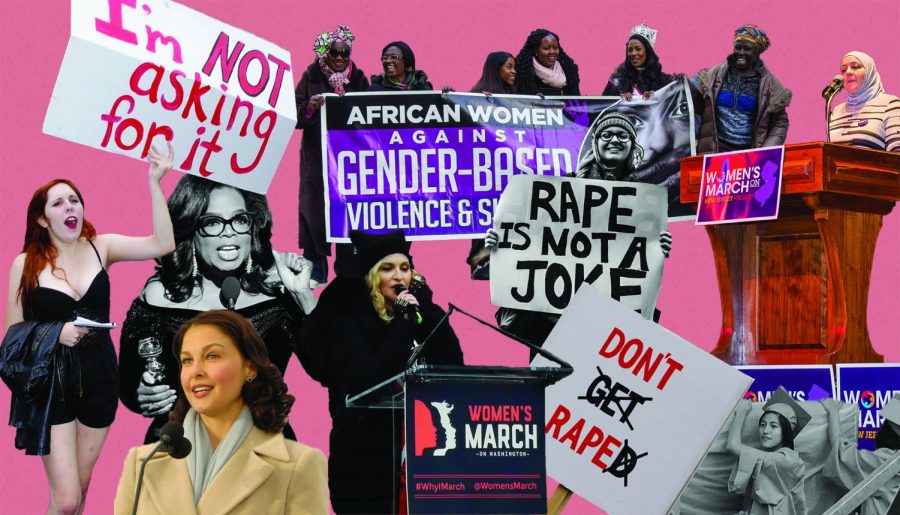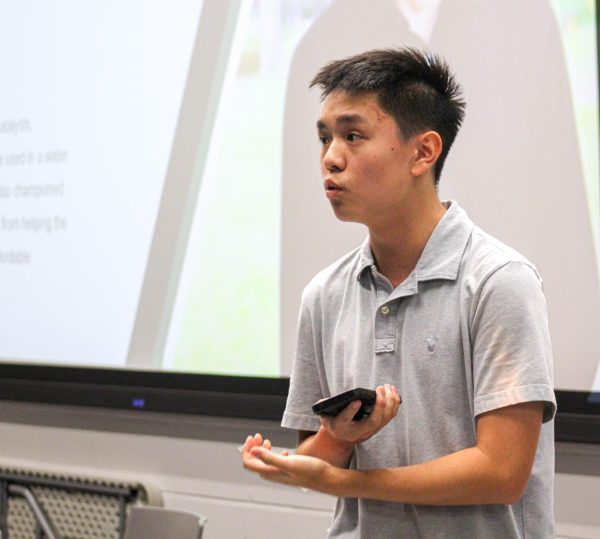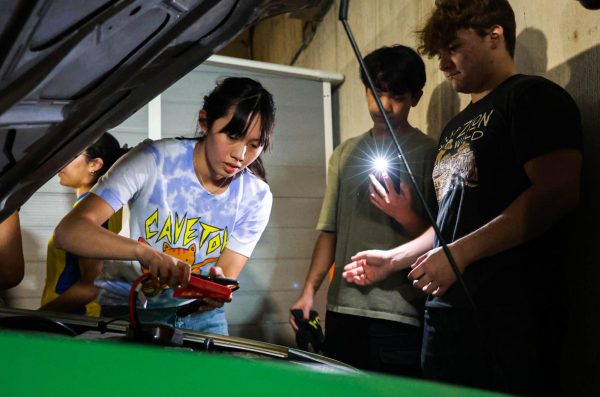#MeToo movement brings attention to rape culture on college campuses
They called her Emily Doe. They called her Jane Roe. They called her Allison. Her name was Faith Ferber, Hailey Rail, Emma Sulkowicz, Camila Valle, Diva Kass, Aryle Butler, Nisha Kavalam, Jasmin Hernandez, Beckett Brennan, Tucker Reed. She was a student at Stanford, at Columbia, at Berkeley, at Baylor, at Louisiana State, at Vanderbilt, at American University, at Indiana University. And these are only the ones the public heard about.
In 2015, the National Sexual Violence Resource Center (NSVRC) reported that, when surveying undergraduate students, 20 percent of women and 6 percent of men stated they had experienced sexual violence through physical force or incapacitation. With the #MeToo Movement thrusting perpetrators into the national spotlight, the discussion about rape and its consequences had shifted.
“DID YOU REALLY SAY NO? HOW MANY TIMES DID YOU SAY NO?”
First coined in the 1970s by second-wave feminists, the term rape culture was used to describe society’s normalization of sexual violence, creating a setting where rape is considered a part of life, something inevitable. Since then, the definition has expanded, describing not only the social situation it occurred in but also the stigmas associated with rape victims. Alumni Lauren Sonik, class of 2016, explained the nuances of the term.
“I would define rape culture as the tendency society has to shame, blame and ignore victims of sexual harassment and assault,” Sonik said. “We as a society tend to relieve the burden of guilt from sexual predators and aggressors by humanizing them, attacking the moral characters of victims and even going so far as to dismiss claims of victims as either overreacting or regret.”
Sonik pointed out that the damage done by rape culture was twofold. Survivors of sexual assault that come forward are often criticised for their actions leading up to the attack with skeptics questioning their morals, clothes, words and any body language they displayed. Equally pressing was the concept that rape is unpreventable and that those who should be held responsible are the victims rather than the perpetrator. Alumni Brittany Terry*, class of 2017, criticized the prevalent mindset.
“After I joined my sorority, we had to watch a video of this guy who took this drunk girl home and how all these different people didn’t stop him, as if it was their fault for not stopping him when he should not have done it,” Terry said. “You’re not doing anything preventative. You’re telling all these victims what to do to prevent things from happening to them, but you’re not telling these people who are doing these things that it’s wrong.”
Alumni Jordyn Kazmouz, class of 2017, agreed and referenced the market that focused on women’s fears of sexual assault. Products such as the lipstick shaped tasers, the compact bottles of pepper spray, the disguised knives, the personal safety alarms, the cat-shaped brass knuckle keychains prey on young women’s desires to keep themselves safe. Social media is inundated with video tutorials teaching basic self-defense to prevent rape or assault. Kazmouz explained the inherent flaws of the mindset that pushed girls to purchase these items or watch these videos.
“You’re not taking steps to actually prevent these things from happening,” Kazmouz said. “You’re putting all this pressure onto the victims to protect themselves. I have my mace in my hand as I’m walking to my car because I work at the Galleria, and I leave at 1 a.m. I’d feel safer if police proceedings were more targeted towards the attacker rather than the victim.”
Terry agreed with Kazmouz, stating that the situation was universal on all campuses. She expressed her frustration with the process of reporting rape, mentioning the demeaning way that victims are talked to and even the cruel accusations of dishonesty thrown at them. Sonik elaborated on Terry and Kazmouz’s points, explaining how such an environment fostered students’ insecurities and doubts about their experiences.
“My friends and I have all had encounters where we felt super uncomfortable but not necessarily justified enough to speak up about it,” Sonik said. “All the time I hear stories of girls, friends even, who went to parties and experienced some variation of sexual assault. It’s common knowledge that you’re not supposed to drink the punch at frat parties since there’s often a running joke about how the fraternity will put Xanax in the punch. Even though we make fun, there’s a real undercurrent of fear and distrust running through female Greek life that makes us have to be really cautious.”
“RAPE HAPPENS EQUALLY. IT CAN HAPPEN TO ANY OF US.”
The cruel reality is that, like most crimes, rape and sexual assault are not indiscriminate. It’s difficult to say that a certain group is targeted more due to their race, ethnicity, sexual or gender identity because of many victims’ choosing not to report sexual violence. However, trends show that, generally, marginalized groups are at a higher risk of rape.
According to the Centers for Disease Control and Prevention (CDC), nearly half of all bisexual people and of transgender people are sexually assaulted. In the LGBT community, 40 percent of gay men report sexual assault other than rape, and 44 percent of lesbians experience rape, stalking, or some other form of sexual assault. Kazmouz elaborated on the phenomenon.
“Definitely, women like me and Brittany, we’re at high risk, but trans women are murdered all the time,” Kazmouz said. “Trans women of color are followed home and raped and murdered all the time. These repeated situations happen all the time. People don’t want to acknowledge it. They say, ‘Rape happens equally. It can happen to any of us.’ Yes, it can, but it happens so much more to these people, these marginalized groups, that already aren’t protected by legislation.”
The complexities of sexual assault shift over racial lines as well. The Connecticut Alliance to End Sexual Violence (The Alliance) reported that, of the women raped in their lifetimes, 6.8 percent are Asian or Pacific Islander, 11.9 percent are Latina, 17.9 percent are Caucasian, 18.8 percent are African American, 24.4 percent are mixed race and 34.1 percent are Native American. Similar trends are seen in men, with mixed race, African American, and Native American men at a higher risk of sexual assault.
However, The Alliance stated that these statistics were heavily influenced by other factors; traditional Asian values discourage women from reporting personal or familial information, and due to cultural pressures, many married Hispanic women are less likely to define their experience of forced sex as rape because of the belief that marital sex is an obligation. Furthermore, the already high statistic of Black women can only be speculative as The Alliance estimated that for every African American woman that reports her rape, at least fifteen do not. Terry explained the complexities of reporting rape within the Black community.
“Black women who are raped by Black men are more afraid to come forward because they know once that Black men get in trouble, there’s a chance that he will die, that he will be shot down,” Terry said. “Black women are not only protecting themselves but also the Black men in their community. He did a bad thing; he did something illegal. He raped her. But when he gets arrested, his life is at a higher risk than a white man who gets arrested for these things.”
Terry referenced the podcast episode of ESSENCE Now with Tarana Burke, creator of the #MeToo Movement, Christina Coleman and Danielle Young. In it, the three women discussed the inequalities of treatment for Black women who report rape, explaining the cultural significance and the harmful repercussions of it.
“It’s drastically different,” Burke said. “Sexual assault doesn’t know any race, class or gender, but the way we respond to it does. There’s also the notion that because of racism and the various oppressions we operate under, Black women almost have to be complicit in their own abuse just to survive. We don’t report; we don’t come forward because look what happens when we do.”
“BOYS WILL BE BOYS. THEY LOVE SEX.”
“Rape culture starts when you’re born,” Terry said. “Rape culture starts when you’re told to like pink or like blue. It starts with the aggressive toys that boys are given and the Barbies that girls are given. We’re taught to be dainty and small and pretty, and boys are taught to be aggressive and tough. We’re both told to be a certain way, and that hurts us growing up.”
When dissecting rape culture, it becomes impossible to ignore its most basic components. Rape culture does not begin at college. It begins with the way that American children are raised and with the values that they are taught. An article written by Kirsten Weir, “The men America left behind,” published on the American Psychological Association’s website, explored the consequences of gender norms.
In her article, Weir defined the term toxic masculinity as an ideology that emphasized “toughness, dominance, self-reliance, heterosexual behaviors, restriction of emotional expression and the avoidance of traditionally feminine attitudes and behaviors.” This definition of manliness often socializes young boys into acting violently or aggressively. In his article “Gender Role Conflict,” published in The SAGE Encyclopedia of Psychology and Gender, William Ming Liu explained that toxic masculinity overlooks trauma in young men’s lives, writing away combative behavior, such as bullying, as “boys being boys.”
Kazmouz pointed out the damage done by this mindset, highlighting the reluctance of men to report sexual assault. She referenced common news articles about boys younger than 13 years old being raped by adult female teachers.
“The stories are always the same,” Kazmouz said. “‘Female teacher arrested for having sex with 13-year-old boy.’ Okay, he’s 13. That is not sex. That’s rape. He cannot consent to that. Men, particularly, when they hear that, they say, ‘Why did he come forward? He’s being a little girl.’”
Terry reiterated that rape culture was ingrained at a young age. She explained how common gender roles negatively impacted men as they grew up.
“Boys are taught at a young age that they’re stronger than women,” Terry said. “‘You need to protect women.’ They think, ‘If a woman made me feel vulnerable, if they took something away from me, then I’m not manly enough.’ Boys are supposed to love sex, and if they have sex with someone they don’t want to have sex with, they think, ‘Oh, I’m supposed to like sex. I was supposed to like this.’”
Terry and Kazmouz both agreed that this issue stretched across campuses, even past them. While Sonik spoke only about her campus, the University of Texas at Austin, she had a similar point.
“Although mental health resources are open to all, men as victims of sexual assault are definitely not as big of a discussion point as female victims, which I do think is a major problem for the university as far as recognition and on-campus resources,” Sonik said. “Fraternity culture as a whole does not really recognize male sexual assault, which I hope will change in the next couple of years since it is just as much of a problem as female sexual assault. I do know of men in Greek life who have been victims of sexual assault, albeit very few, and they have recently been speaking out about their experiences, so I think that is a good start.”
“SO YOU’RE JUST GOING TO IGNORE ME NOW? I BOUGHT YOU THIS DRINK. I DESERVE MORE THAN JUST THIS.”
In 2013, an email was sent to members of the Phi Kappa Tau Fraternity at the Georgia Institute of Technology, giving a vulgar and “rapey” guide to picking up women at parties. The email detailed how the pledges should talk to women, how to dance with women, and how to coerce women into having sex. While the sender explicitly said, “NO RAPING,” the contents of the email seemed to confuse what consent actually meant. He listed his “7 E’s of HOOKING UP:” encounter, engage, escalate, erection, excavate, ejaculate and expunge, reminding his readers to ply a woman with alcohol if she is unresponsive to their advances. At the end of his piece, the man signed off with the phrase, “In luring rapebait.”
A year later, Georgia Tech disbanded Phi Kappa Tau for breaking the student code of conduct. Only recently, in July 2017, was the fraternity able to reinstate itself on campus. This wasn’t the first time a fraternity had faced controversy over a rape scandal. In 2010, pledges of Yale University’s Delta Kappa Epsilon Fraternity marched through campus shouting, “No means yes, yes means anal.” In 2012, Wesleyan University was sued by a former student for overlooking the actions of the Beta Theta Pi Fraternity, also known as the “Rape Factory.” In 2007, the College of William and Mary released a study by John D. Foubert, Jonathan T. Newberry and Jerry Tatum that stated men in fraternities were three times more likely to commit rape. With consistent backlash, Greek life on campuses has been watched with a critical eye. Sonik, an active member of a sorority, described her own experiences.
“I had a good friend tell me that she was highly allergic to Xanax, and once when she drank the punch at a mixer with a frat, she broke out in hives,” Sonik said. “I had another friend tell me that at one party a guy offered her water that she most likely believed had molly in it, which caused her to lose most of her memory of the night.”
Terry, also a sorority member, shared a similar caution around fraternities. While she attends a school outside of Texas, her concerns seemed universal.
“To keep myself safe, I just don’t go to frat parties because they scare me,” Terry said. “The thing about my school is that we don’t have big frat parties, but we have a big place where there are around ten bars. When people go out, they don’t go to a frat party, they go to a bar. It’s mainly sorority girls and frat boys going there, trying to hook up. I have a boyfriend, so when I go to the bar, I’m not looking to hook up with a guy, but that’s all the guys are trying to do.”
She recounted an experience at a bar with her fellow sorority members. Because her friends were asking men to buy them drinks, Terry decided to participate. But when the man she had asked returned with her drink, he quickly became agitated when she made it clear she wasn’t interested.
“He said, ‘I just bought you this drink. I deserve more than just this,’” Terry said. “I thought, ‘Wow, he really thinks he deserves something. He chose to buy me this drink, and now he’s expecting me to go home with him.’ He thought he deserved something from me. He did something small for me, and now he deserves for me to go home with him.”
Terry and Sonik both expressed gratitude for their sorority sisters and friends. Sonik explained their system for keeping each other safe, even speaking about the role that her friends in fraternities played.
“My sorority sisters and I always talk about different ways we can educate and help one another, especially during high-risk weekends like OU Weekend, Halloween, and Roundup,” Sonik said. “Personally I have very close relationships with a lot of guys in Greek life and I would consider most of them to be among my best friends. When I’m with them or at their parties, I absolutely feel safe and I know that they are always looking out for me and my friends, even if there’s not a party going on and we need help with something or just want to hang out.”
While thankful towards her own sorority, Terry mentioned that the culture of Greek life could be toxic. She explained that the image of an organization was important and often influenced the way that they treated their members.
“I’m very fortunate for the sorority that I’m in,” Terry said. “My friend told me that her sorority promotes them getting drunk at parties and hooking up with boys. They want to look like those girls. Their thoughts were, ‘We go to parties, and we hook up with boys. We’re those girls.’ They promote that to their younger members. Thankfully, my sorority isn’t like that. They’re very different. If that happened to me, I’d be out of there quick. Being in a sorority is hard to navigate because I feel like there are so many bad things that are being said about it, and I believe all those bad things.”
While both girls were wary of fraternities, they both noted that the environment had shifted. Terry cited a case in which a fraternity expelled a member after rape allegations came out against the man . Sonik emphasized that Greek life can be very diverse and that forming a cohesive image of all organizations can be difficult.
“There are a lot of fraternities and, as with any social organizations, there are a lot of different kinds of people involved, some good and some not so good,” Sonik said. “Allegation of sexual assault will tarnish a frat irreversibly. Again, there are 28+ fraternities on the UT campus, so I choose to hang out with great guys who are educated, socially aware and responsible. Greek life is simply an amalgamation of different groups with different attitudes and personalities, and if one chapter acts malevolently the rest of us will denounce those actions wholeheartedly. There is no place for sexual assault or violence in Greek life, as in any place in society.”
“WHY DON’T YOU JUST TELL THE POLICE? IF YOU KNOW WHO DID IT, JUST TELL THE POLICE.”
Merriam-Webster’s dictionary defines rape as an unlawful sexual activity carried out against a person’s will or with a person incapable of giving consent. While seemingly straightforward, when putting the crime into law, the nuances become important. State laws regarding rape vary wildly; some places, such as New York and Alabama, have different laws for different sexual acts, each with the same severity, but other states, such as Arizona, consider some forms of penetration as “lesser crimes” than rape. A brief glance the Rape, Abuse & Incest National Network (RAINN)’s compilation of sexual assault crime definitions is overwhelming, the number of statutes defining different forms of rape ranging from three to ten.
All this legal jargon can be intimidating to victims. RAINN reported that 80 percent of female rape survivors on college campuses do not report the crime. Even when survivors of sexual assault know their rapist, many are tentative to go to the police. Kazmouz explained the reasoning behind such a decision.
“I don’t think a lot of people understand that when you’re a victim of sexual assault, you’re constantly reliving it,” Kazmouz said. “They don’t realize that court proceedings aren’t a one and done kind of thing like in Law and Order. Your life isn’t Law and Order SVU. Everything isn’t over in an hour. I know this girl who is going through a court proceeding for someone who raped her, and it’s been going on for four years. He still has not been convicted. There’s tons of evidence against him, and he has still not been convicted. Every time they go to court, every time she has to make an appearance, every time she’s interviewed by the police, she has to relive the things that happened to her.”
Kazmouz emphasized that even if a victim decided to report a crime, the evidence necessary to bring a charge may be difficult to collect. Victims are encouraged to obtain rape kits, also known as sexual assault kits (SAK), in order to gather evidence for their case. However, even that basic request can cost thousands of dollars. Kazmouz tied these costs back to the overarching issue of rape culture, explaining the consequences of placing such a responsibility on the victim.
“I should be safe, but I shouldn’t have to worry about that all the time,” Kazmouz said. “I shouldn’t have to think, ‘If I’m in a situation where someone is attacking me, I have to make sure to leave evidence to show that this was not consensual.’ If you want to go to the police, you have to have his skin under your fingernails or something. You have to fight back to prove it wasn’t consensual.”
Most schools separate the legal proceeding from their own decision. Some schools will expel students accused and convicted of rape, while others will not. If they decide to report sexual assault, survivors must choose whether they will go through both avenues to cause change. Most campuses have resources for students that have experienced sexual assault, and many include information about consent and preventing rape during orientation. However, Terry expressed concern that schools may be acting out of self-preservation rather than out of care for victims.
“The thing with a university and any type of drama is that they don’t like to talk about it,” Terry said. “When they try to fix the situation, they’re just trying to save themselves not the actual students. My school has done this a lot recently. There was a sorority girl who was assaulted and raped, and we have to go to seminars now, but they’re not making any rules to actually make it harder for these things to happen. We’re having to protect ourselves more than I feel like we should.”
While Sonik generally approved of UT’s culture surrounding sexual assault, she also had suggestions for improving universities’ procedures, including creating a longer, more intensive seminar for sexual assault prevention for students.
“I do think that students would feel comfortable reporting sexual assault here,” Sonik said. “It’s a conversation that we are having all the time and I think we really try to take the shame and stigma out of it. Most of the time it’s encouraged to try to step in and intervene if you can while the assault is happening. UT should also install services for victims that might require physical needs after an assault that don’t align completely with Women’s health services, especially for male victims.”
Kazmouz mentioned that the University of Houston (UH) also had ample resources for students. She had a similar criticism as Terry, stating that many times it seemed as though the university was acting to save its own image, but she believed that its resources would still benefit victims.
“At UH, I think there are several different safety nets for girls who are sexually assaulted,” Kazmouz said. “We have a Title IV coordinator, and his job is to deal with sexual assault allegations. There’s the police, the free clinic for students, campus police. There are free psychological services for students. There are several different avenues you can take if you’ve been a victim of sexual assaults at UH. You don’t necessarily have to pursue legal action, but there are support groups for victims.”
“GUYS, ASK HER, ‘CAN I KISS YOU NOW?’”
Within hours of the New York Times’ publishing of “Harvey Weinstein Paid Off Sexual Harassment Accusers for Decades,” the dialogue about rape had shifted. Five days later, on Oct. 10, 2017, the New Yorker published their own piece, detailing the testimonies of 13 other women who had been sexually assaulted by Weinstein. By Oct. 15, #MeToo, a hashtag created all the way back in 2006 by Tarana Burke, began circulating on Twitter, reignited by actress Alyssa Milano.
In the few months after the #MeToo movement gained steam, a cultural reckoning had begun. For one of the first times, the public began to see powerful figures being held accountable for their actions. Sonik noted the change she had seen in the Greek life at UT.
“We’re not afraid to stand up and tell our stories, and it’s not cool to be a rapist in a frat, unlike a few years ago,” Sonik said. “We are committed to looking out for one another and making sure everyone feels safe and protected as much as possible at all times. We make sure that no sister is ever left behind. I feel that there is a shift taking place in fraternity life, and it especially comes in part with the #MeToo movement.”
The effects of the #MeToo movement caused a reckoning for rapists and assaulters, and it also served as a beacon of hope to survivors. Kazmouz explained how the hashtag was inspiring.
“You look on social media, and you see people acknowledging sexual assault,” Kazmouz said. “If you look on Twitter and Instagram, people are saying, ‘Yeah, me too. I’ve been a victim of sexual assault as well. I’m a survivor as well.’ I think that having this conversation and seeing these issues brought to life is definitely super empowering for victims.”
Terry agreed that the movement was beneficial for all victims in many ways. While most people are not celebrities, #MeToo gave all survivors of sexual assault a form of unity and strength as well as a platform to share their stories. Terry emphasized the positive impact that this has made for all victims, but especially those of marginalized groups.
“Things are changing slowly, but I think just talking about it makes things better,” Terry said. “As white women, I believe we have privilege, and we have a platform to speak and to be heard. Now we are sharing our platform, and things are changing. Sexual assault has always been an issue, but now that it’s famous people being assaulted? ‘Well, I guess it’s real now.’ But what these people are doing is sharing their platform with other survivors who have been sexually assaulted or raped or harassed.”
Not only did #MeToo create a sense of unity, it forced people to examine different aspects of how society treats rape victims. While allegations brought to life during the #MeToo movement were only recently showcased in the spotlight, many of them occurred years ago, some even decades. These older cases showed the shift in the conversation about sexual assault, revealing the progress that had been made to combat rape culture.
“I am very fortunate that my freshmen year of college is at this unique intersection of all these things happening and the media making the world so much closer than it’s ever been,” Kazmouz said. “We just live at this perfect intersection of these two things. We can actually see change happening. It’s so important to be a part of the conversation and to be a part of the voice for change. You just need one person to come forward.”
*Brittany Terry’s name has been changed for her personal privacy
Your donation will support the student journalists of Bellaire High School. Your contribution will allow us to purchase equipment and cover our annual website hosting costs.







